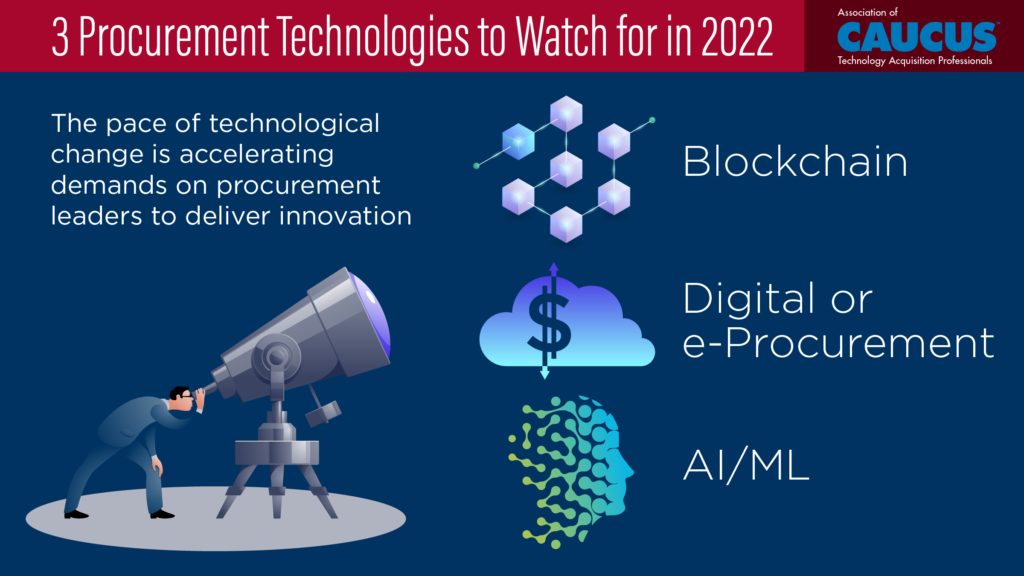3 Procurement Technologies to Watch for in 2022
Not since World War II, has the procurement profession been so disrupted as with the COVID-19 pandemic. COVID-19 revealed how globalization can both spread a virus and cripple supply chains. In response, procurement leaders are transforming themselves. By building new capabilities and ways of working —from data management to Artificial Intelligence (AI). Still, procurement professionals will attest to the long-standing challenges around supply chain efficiency, information access and sharing and asset traceability.

We offer some technology trends to monitor and watch in 2022 that may help solve these long-standing challenges.
1. Distributed Ledger Technology (DLT) Blockchain. Is the underlying technology behind Bitcoin. What is Bitcoin? It is a form of digital cash (cryptocurrency) to which unit transactions are encrypted and recorded on a digital ledger called a “blockchain”. This digital technology is considerably faster than current processes by allowing units (data) to be distributed but not copied over the internet.
Enter “Blockchain 3.0”.
Large complex datasets and transactions are business as usual for procurement and supply chain professionals. This translates into bottlenecks and delays.
Blockchain 3.0 offers lightweight applications and integration with Artificial Intelligence (AI) Cyber security applications and Machine Learning (ML) algorithms. Allowing users the ability to accelerate transaction performance and better protect sensitive data.
Expect vendors and service providers (e.g., AWS, Ethereum 2.0 and IBM) to demonstrate the viability for blockchain pilots or proof of concept (POC) to better manage the flow of data and services between various provider and supplier computers and networks.
Monitor and participate in pilots and POCs that include:
- Integration with cybersecurity services to better protect sensitive data.
- Automate cross-border payments, purchase orders and shipping notifications.
- Information sharing and efficiency using programs stored on blockchain (smart contracts). That executes automatically when predetermined conditions are met.
- Blockchain-based traceability that reduces fraud and offers real-time tracking of assets.
2. Digital Procurement. Procurement as a Service. Many procurement leaders for various reasons struggle with information sharing, good quality data and high overhead costs. In response, many procurement professionals are adopting third-party procurement service providers (e.g.CA Technologies, GEPSmart and Tata Consultancy Services) to modernize their own processes and technologies, lower their own employee costs and reduce organizational inefficiencies, errors and delays.
These cloud and SaaS-based services combine technology and expertise to manage a portion, if not all, of your organization’s procurement functions, such as contract lifecycle management, spends and workflows. These services can also lower upfront investments, reduce duplicity and enhance real-time data management.
Some of our members use the best practice of using these services to grow from initial non-critical purchases supplementing internal procurement to more complex transactions as their experiences and staff expertise matures.
3. Data complexity must be conquered. Procurement professionals struggle with providing accurate and timely data to all stakeholders. Seeing value from Artificial Intelligence (AI), Machine Learning (ML) algorithms and analytics begins with data you can trust. That trust relies on how data is collected, shared, protected and used.
Enter “Artificial Intelligence (AI) and Machine Learning (ML)” algorithms. That are defined as:
AI-is any smart algorithm that solves specific problems.
ML- is any algorithm that detects patterns and uses them to make predictions.
All forms of AI and ML involve algorithms which are a set of programmable rules specifying how to solve a specific problem. Able to automate time-consuming tasks and analyze large data sets. By performing cognitive functions, such as, pattern recognition, learning and problem solving. That increases efficiency and accelerates decision-making. Some of our members are automating repetitive and routine processes to search through data to discern patterns, track KPIs and predict disruptions in real-time.
Expect companies, such as, AWS, Google, InData Labs, Microsoft and Spire Digital, to offer “find what you need” services to help you automate tasks, such as, purchase approvals or spend analysis.
By T Jeff Vining, Executive Director of CAUCUS The Association of Technology Acquisition Professionals
Learn more about CAUCUS by calling 407-740-5600 or clicking the link above.
Sources:
Amazon business
Trusted Tech Team
The Analyst Syndicate
2022 Tech Trends I Deloitte Insights

